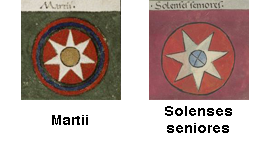
This page created 7 June 2014, and last modified: 25 July 2015 (Maier reference numbers added)

The Solenses seniores is listed (18.12 in Ingo Maier's numbering scheme) as the most senior of the infantry units under the Magister Militum per Thracias. Its shield pattern (16#2) as shown in various manuscripts, under the matching label (16.b) Solenses seniores, is as below:

The shield pattern is relatively simple, with a red main field charged with a white 7-pointed star, and a blue boss showing quartering lines but without differentiated colours (the star has 8 points in M and B; the points in B also include ribbing). Seven-pointed stars are very rare in the Notitia; the only other infantry example belongs to the Martii under (21.16) the Magister Militum per Illyricum.

The Solenses seniores might date from the time of Constantine the Great (who was devoted to the worship of Sol before converting to Christianity), or, even more likely, from the time of his father, Constantius Chlorus, who was associated with Sol in the same way Diocletian was with Jupiter, Maximianus with Hercules, and Galerius with Mars. Appropriately enough, its shield device is indeed a solar emblem, a star, although not too much need be read into this, given the shield pattern of the Martii, and possibly named for Galerius, also shows a white seven-pointed star, as the above patterns taken from the Parisian manuscript show; the two units may well have been initially brigaded together when they received their shield patterns. The Solenses Gallicani, also under the command of the Magister Militum per Thracias, might be an offshoot of the Solenses seniores, perhaps split off from their parent while in Gaul, although it may just be the same unit as the otherwise missing Solenses iuniores (see further, below). The Cuneus equitum Solensium under the Dux Scythiae might perhaps be the former cavalry component of the legion.
Interestingly, in addition to the above named units, there is also a Praefectus numeri Solensium serving under the Dux Britanniarum (Britain was where Chlorus died, and Constantine was acclaimed Augustus there by his troops). In Britain, there were traditionally three legionary units, but one, Legio XX Valeria Victrix, is absent from the Notitia, and indeed, from all records after the 3rd century. One might speculate that the original Solenses, rather than being a unit newly raised by Constantius Chlorus, was (part of) the old Legio XX Valeria Victrix renamed. The latest evidence for the legion's existence in Britain is its appearence on the coins of Carausius, the rebel ruler of Britain whose successor (and murderer) Allectus was suppresssed by Constantius Chlorus, a hundred years before the Notitia was compiled. Whether Carausius included it in his coinage in a bid to buy its loyalty, or to show that it was loyal to him is unproveable, but since the Sixth legion of Britain was not included on his coinage, while inscriptional evidence for it comes from his reign, the balance of evidence suggests an attempt to buy the loyalty of the 20th, as that of the Sixth seems to have been given freely.
Either could support a transformation of the 20th legion into the Solenses. If they disdained Carausius and remained loyal to central authority, they could have been awarded the name Solenses as an honour. If they rebelled, they may have been renamed by Carausius as a reward (to some other name), which would no doubt have required a subsequent renaming by Constantius or Constantine (since all traces of usurpers were to be expunged as far as possible). I would suggest a renaming following rebellion. As Carausius rebelled against his emperor Marcus Aurelius Valerius Maximianus, better known as Herculius, he had every reason to rename a legion whose name meant 'Victorious Valerians', whereas both Constantius and Constantine, i.e. Flavius Valerius Constantius and Flavius Valerius Constantinus, respectively, would have had every reason to keep its for-them well-omened name intact, for precisely the same reason.
As note above, no unit called the Solenses iuniores is recorded in the Notitia; this might be equated with either the Thracian Solenses Gallicani, or the men under the British Praefectus numeri Solensium, or simply be missing due to in the meantime having been disbanded, destroyed, or simply renamed.

Return to the Notitia alphabetical unit list page.
Return to my Notitia index page.